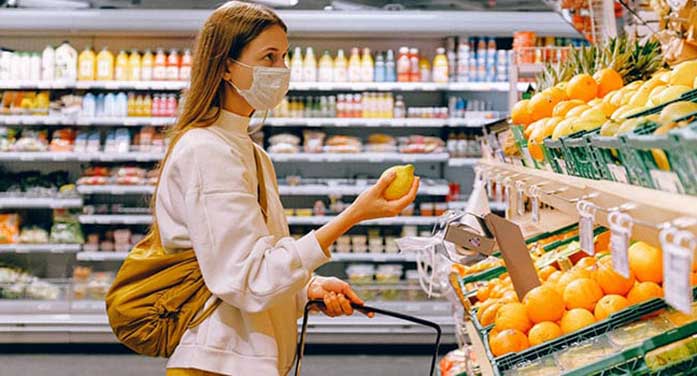 Canadians’ ballot decisions in the Sept. 20 federal election will likely differ depending on what you really care about. But since everyone eats and most of us try to manage a limited food budget, the most important electoral issue will likely be inflation.
Canadians’ ballot decisions in the Sept. 20 federal election will likely differ depending on what you really care about. But since everyone eats and most of us try to manage a limited food budget, the most important electoral issue will likely be inflation.
Or at least it should be.
Everything is costing Canadians more, including food. And the worst is yet to come, especially if the COVID-19 Delta variant ruins it for many of us this fall.
By December, the average Canadian household will have to pay five per cent more for groceries, or about $700 more a year.
This is the largest dollar-value increase in history. And it could be even higher in 2022.
As the impact of climate change made evident this summer, the situation will be increasingly unpredictable and chaotic for agri-food businesses, from farm to fork.
And COVID has had its say in the operability of food chains and the costs that businesses must bear to make sure we have enough to buy at grocery stores and restaurants.
 Due to COVID, global supply and demand for almost everything is completely distorted. Demand is very strong for several products, including food.
Due to COVID, global supply and demand for almost everything is completely distorted. Demand is very strong for several products, including food.
This pent-up demand puts enormous strain on supply chains. Every sector is fighting to get more cargo space.
Some economies are recovering much faster than others, which makes logistical predictability a nightmare.
And sanitary measures everywhere are causing the supply chain to operate a little more slowly while its costs increase.
The maritime transport industry has been particularly hard hit by the pandemic, which will have long-term consequences. Freight rates have increased by more than 200 per cent on average over the past year.
A world economy that finds Asia and America completely at odds means there’s a shortage of containers and ships. Since January, around 170 new high-capacity freighters have been ordered by various logistics companies. But these ships won’t be delivered before 2023. So don’t expect the problem to be resolved before then.
The food chain is trying to be kind to consumers by absorbing some of the costs caused by expensive transportation. But by this fall or winter, retailers and restaurateurs will have no choice but to adjust their prices – upwards, of course.
Many federal policies don’t help consumers, and some even contribute to food inflation.
Subsidized unemployment benefits have contributed to a shortage of workers of all ages, not just young people, which means employers must pay much more in labour costs to get people back to work.
Higher wages are certainly desirable, but there are hardly any incentives to encourage work or retraining, especially among those 55 years old and over, where the level of employment has fallen the most in the last year.
All of this will catch up to consumers. If they haven’t noticed higher food prices yet, they will soon.
Since 2019, the Trudeau government has shown extreme generosity toward the agri-food sector. It has said yes to almost everything – the food waste program, compensation for farmers, financial support for food processing and food safety.
And if we add the programs created to mitigate the effects of the pandemic, such as the Canadian seafood stabilization fund, the emergency processing fund, the emergency food security fund, the recovery program food surpluses and the Nutrition North Canada program, the sums are simply colossal.
All these programs exceed $2.5 billion. That’s $65 per Canadian.
Canadian industry is in dire need of financial support. But by saying yes to everything, the federal government is still offering us policy without a vision, without clear priorities. Decisions often lead to inconsistencies among different sectors, different markets and especially among provinces. Tackling interprovincial trade barriers would be a good place to start.
Of course, the pandemic is not solely responsible for higher food inflation. There are multiple factors. The Western world is grappling with an inflationary situation that could hurt many of us. So Canada isn’t alone.
But the arch-generosity of the Liberals has reached a perilous threshold. The federal funds create hyperstimulation of demand, causing prices to inflate at an unsustainable rate. Food isn’t immune.
The average Canadian pays more in taxes than for food, clothing, and housing or mortgage combined. Taxation’s impact on our lives is of the utmost importance.
While taxes may not go up for many of us, the cost of living will. So the future cost of food needs to be addressed in this election campaign.
Otherwise, even if candidates running for office hammer home the message that taxes won’t increase, food inflation – a hidden, regressive ‘COVID tax’ – is an issue for people who are struggling financially.
Dr. Sylvain Charlebois is senior director of the agri-food analytics lab and a professor in food distribution and policy at Dalhousie University.
Sylvain is one of our Thought Leaders. For interview requests, click here.
The views, opinions and positions expressed by columnists and contributors are the authors’ alone. They do not inherently or expressly reflect the views, opinions and/or positions of our publication.
© Troy Media
Troy Media is an editorial content provider to media outlets and its own hosted community news outlets across Canada.


